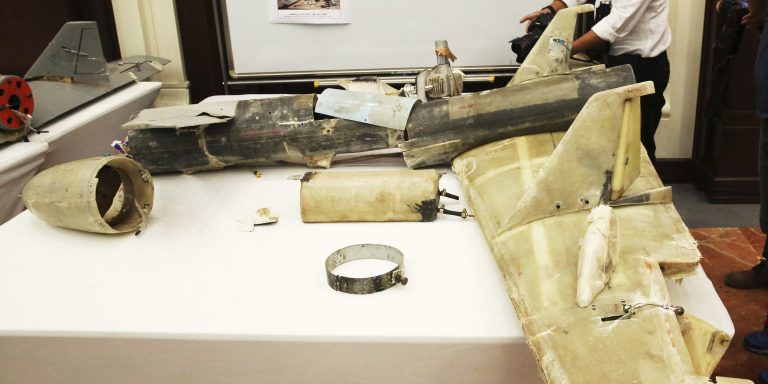INTELBRIEF
January 19, 2022
IntelBrief: Iran-Backed Houthis Project Power Against the United Arab Emirates

Bottom Line Up Front:
- An apparent armed drone attack that damaged oil storage facilities in the United Arab Emirates demonstrates the ability of the Houthis in Yemen to use Iranian technology to project power against regional adversaries.
- The attack, which killed three expatriate workers, represents Houthi retaliation for the recent offensive by UAE-backed forces in Yemen’s Shabwa Province.
- The Houthis are targeting the UAE because it remains extensively involved in the ground conflict in Yemen despite announcing a pullback of its forces in 2019.
- The Houthi strike comports with the strategy of the group’s mentors in Tehran to intimidate and pressure the Gulf states and other regional opponents of Iran.
On January 17, several armed drones struck three petroleum transport tankers near a storage facility for the Abu Dhabi National Oil Co. (ADNOC) 13 miles from the center of Abu Dhabi city. The attack also caused a small fire at Abu Dhabi’s international airport nearby. The oil storage facility hosts a pipeline network and 36 storage tanks that provide fuel nationwide. The strike reportedly caused minor physical damage but killed three expatriate workers from India and Pakistan and wounded six others. The Iran-backed Houthi movement that has captured significant territory from the UN-recognized Republic of Yemen government left no doubt about its responsibility; a Houthi military spokesman stated that the group had launched an attack deep in the UAE. UN Secretary-General Antonio Guterres, whose special envoys have sought unsuccessfully to broker a political solution to the Yemen conflict, “condemned” the attack and called on “all parties to exercise maximum restraint and prevent any escalation.” His spokesman Stephane Dujarric added, “Attacks on civilians and civilian infrastructure are prohibited by international humanitarian law.” The attack came as South Korea’s President Moon Jae-in was visiting the UAE to discuss a $3.5 billion deal to sell mid-range South Korean surface-to-air missiles.
The Houthi strike illustrates the growing ability of the movement to use Iran-supplied technology to project power against its battlefield adversaries, even far beyond Yemen itself. The UAE targets struck are over 1,000 miles northeast of Saada, the Houthis’ stronghold in Yemen. The Houthis have previously sought to strike inside the UAE—a mainstay of the Saudi Arabia-led Arab coalition seeking to restore the full authority of the Yemen government. However, previous Houthi ballistic and cruise missile attacks on the UAE have failed, including a 2017 purported strike against the UAE’s Barakah nuclear power plant. Iran-supplied armed drones, which the Houthis are increasingly proficient in using, allow for more precise targeting and increased effectiveness. The Houthis have had significant success firing ballistic and cruise missiles on the Kingdom of Saudi Arabia—which borders the Houthis’ strongholds in northern Yemen and is much easier to target than the UAE—frequently hitting Saudi airports and oil facilities and pipelines.
The Houthi strike on Abu Dhabi came amid escalating hostilities between the two combatants. On January 3, the Houthis seized a UAE-flagged ship, the Rwabee, off the coast of Yemen, and they continue to hold the 11 crew members. Claiming the ship was carrying military equipment, the Houthis rejected a January 14 call by the United Nations Security Council to release the ship and its crew. The UAE called the seizure a “dangerous escalation” in the busy Red Sea shipping route. The ship seizure and drone attack seemed to represent Houthi retaliation for the early January offensive by UAE-backed Yemeni forces that succeeded in capturing all of the southern province of Shabwa. The victory threatens to cut major Houthi supply lines for their attacks on the key city of Marib, the last government stronghold in northern Yemen. The Houthis have repeatedly rebuffed UN and U.S. diplomatic efforts to halt the Marib offensive. The Shabwa offensive was spearheaded by a pro-government militia, the Giants Brigades, that has extensive support from the UAE military—demonstrating that the UAE remains pivotal to Saudi-led ground operations in Yemen, despite pulling the bulk of UAE forces from key Yemen fronts in mid-2019. For the Houthis, more extensive UAE involvement in Marib, in particular, represents a clear red line.
The conflict in Yemen and the Houthi missile and drone attacks on the UAE and Saudi Arabia are inseparable from the overarching power struggle between the Gulf states and their allies, including the United States, and the Islamic Republic of Iran and its armed surrogates throughout the region. At the same time, Tehran has made it known that it can compartmentalize its relationships in the region, and it can do so according to specific theatres. Iran’s transfer of ballistic and cruise missiles and armed drones to the Houthis is a key component of Iran’s strategic goal of positioning it and its allies to project power throughout the region. Houthi attacks on the Gulf states most vocal in opposing Tehran, including Saudi Arabia and the UAE, not only serve Houthi battlefield interests but also advance Iranian efforts to intimidate and wrest concessions from the Gulf states. Appearing to reinforce the linkage between the Abu Dhabi attack and Iranian strategy, some experts noted that the drone strike came days after Iran-backed groups threatened to strike Abu Dhabi in response to alleged UAE interference in Iraqi politics on behalf of parliamentarians pushing back against Iranian influence. The Houthi escalation against the UAE indicates the need for an increase in diplomacy and engagement between Iran and the Gulf states, not only to end the Yemen conflict but also to lower tensions in the Gulf more broadly in the hope of avoiding an expanded regional war.